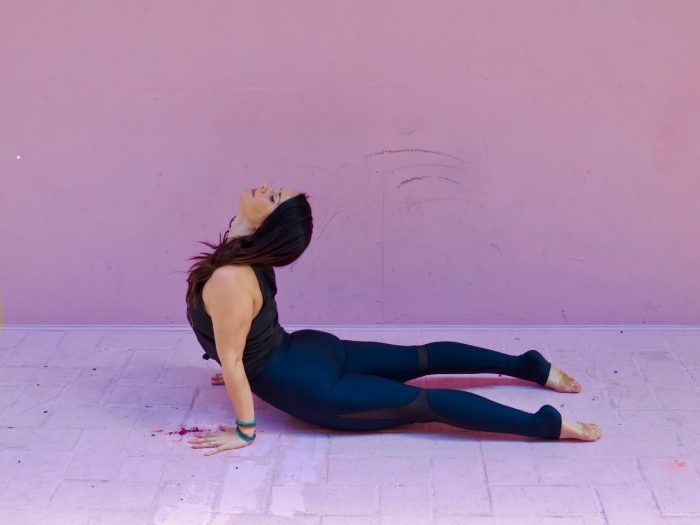Many period advice books out there recommend yoga as a nourishing physical activity to do during menstruation, but this is not always the best advice.
As both a women’s health coach specializing in reproductive health and a KPJAYI-authorized Ashtanga teacher, the subject of menstruation and yoga practice is of great interest and importance to me.
This is why I often find it frustrating when reading guides on women’s health that suggest yoga as the ideal activity to practice while bleeding.
My teacher, R. Sharath Jois, advises female practitioners to take a full three days of rest during menstruation. Some female practitioners disregard this instruction as they feel it is an outdated guideline based on a male-dominated culture (perhaps you have seen the hashtag #ICanDoAnythingYouCanDoBleeding), but I encourage us to look at this advice from a different perspective.
Yes, we can do yoga while bleeding, but why should we?
The female reproductive system is an extraordinary mechanism of beauty and amazement.
As females, it’s a privilege to have the opportunity to bleed, cleanse, and replenish each month. Our periods are also an invaluable tool to gauge our overall health and well-being, so much so that the American College of Obstetricians and Gynecologists deemed periods as a fifth vital sign.
It’s not just the traditional lineage of Ashtanga that advises women to stop asana (yoga pose) practice for three days, but the tradition of Iyengar yoga recommends to rest or take a modified practice on days of bleeding as well.
Dr. Geeta Iyengar, the daughter of B.K.S. Iyengar, writes “A healthy menstruation is a significant indication of a healthy state of body and mind. We have to respect our womanhood, we have to respect our bodies which have got this very important function to perform. Obviously, we need to adjust our practice. If we do not respect this fact, then we are disrespecting our own existence as well as that of the future generation.”
In yoga, we call energy prana. There is both apanic (downward) and pranic (upward) energy. During the time of our period, we want the energy to move downward in order to cleanse the body, not only on a subtle body level but on a physical level.
Subtly, there is powerful energetic work at play that could negatively affect our system overall and prevent the natural cleansing process of our cycle. Physically, we need to encourage the uterine lining to shed, and twists and inversions can arrest this flow, as well as cause cramping.
Essentially, when we practice during our period, we are working against the natural downward energy taking place in our bodies.
Interestingly, in Chinese medicine this energy is referred to as Qi, and similar principles apply, as practitioners of Chinese medicine are also taught to take a rest for three full days during menstruation.
In the West, people tend to practice yoga in big group classes, making it impossible for the teacher to give individual attention to each student.
It is a common practice for people to frequent classes at many different studios, never establishing a strong teacher/student connection. In this scenario, it is doubtful a student will approach a teacher they’ve never met to disclose that they are on their period. Without this disclosure, the teacher will not know to modify the practice for this student.
Additionally, if a female on their cycle is taking advice from her period wellness guide to slow down, she might end up in a dynamic type of yoga class such as Vinyasa or power yoga. In these classes, there will most likely be some twists and inversions. Not only will this type of yoga increase heat (which we absolutely do not need while menstruating as our body is already heated in this phase of our cycle), but the twists and inversions can aggravate our uterus.
However, the period guides aren’t all wrong! There are some types of yoga that do jive well with our menstrual cycle.
If opting for a group class, look for a restorative yoga or Yin yoga class, but if practicing at home, try these asanas:
>> Baddha Konasana (butterfly)
>> Supta Baddha Konasana (reclined butterfly)
>> Legs up the wall
>> Balasana (child’s pose)
>> Sukhasana (final rest)
Hold each one for at least five minutes. A pillow or bolster can be used for support.
If you are currently suffering from amenorrhea (absence of menstruation), I encourage you to take a few days of rest over the new moon. Invite your monthly bleed to return by creating the time and space for her. Perhaps sit in seated meditation during these days and reconnect with your womb by placing your hands on this sacred space and visualizing your flow beginning.
If we continue to practice for months without rest because we have not had a period, the chances of bringing it back gets smaller; it’s a vicious cycle.
We must nurture our bodies and invite our feminine, yin energy to enter, in order to balance out the type A, yang energy, that in today’s world of unprecedented stress, is all too easy to dominate.
Remember, our goal for this time of the month is to nurture our bodies. Females are cyclical beings, and we must remember this. We weren’t designed to go hard every day of the year. The time of our menstruation is an opportunity to slow down and give gratitude to our body for all of its hard work.
It is not a sign of weakness to take a break from our asana routine. A wise woman knows she must take care of her temple—she knows the practice will still be there when she stops bleeding.
~







Read 0 comments and reply